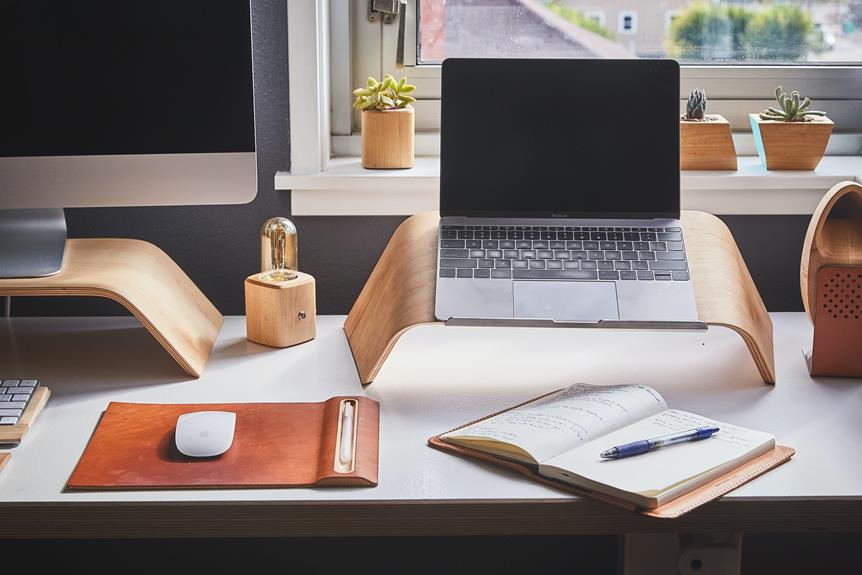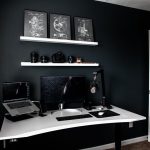You want your home office mic to be the unsung hero in your workspace, delivering crisp and clear sound without any hiccups. To achieve this, you need to master the art of setting up your mic like a pro.
From choosing the right microphone to minimizing background noise, these 5 essential tips will elevate your audio game to the next level.
Let's dive into the nitty-gritty details of positioning, configuring, and optimizing your mic for top-notch performance.
Get ready to transform your home office into a professional audio haven with these expert tips.
Key Takeaways
- Assess your needs and budget to choose the right microphone for your home office setup
- Select a location with minimal background noise and good acoustics for optimal audio quality
- Position the microphone properly to reduce unwanted noise and interference
- Adjust audio settings and use soundproofing materials to minimize background noise and enhance audio quality
Choosing the Right Microphone
You should regularly assess your needs and budget to determine the best microphone for your home office setup.
When it comes to microphone types, there are several options to consider. For those on a budget, dynamic microphones are a solid choice. They're versatile and can handle high sound pressure levels, making them suitable for various recording situations.
Another budget-friendly option is a USB microphone. These are easy to set up and offer good sound quality for voice recording, making them ideal for conference calls and online meetings.
If you have a bit more flexibility in your budget, you may want to explore condenser microphones. They're known for their sensitivity and wide frequency response, making them perfect for capturing vocals and acoustic instruments.
Shotgun microphones are another type to consider, especially if you have a dedicated home office space and need to focus on capturing sound from a specific direction while minimizing background noise.
Ultimately, the best microphone for your home office setup will depend on your specific needs and budget. By understanding the different microphone types and budget options available, you can make an informed decision that will enhance your home office audio setup.
Setting Up the Ideal Location
Select a location with minimal background noise and good acoustics for optimal microphone performance. When setting up your home office mic, finding the right spot is crucial. Choose a room with minimal echo and reverberation to ensure clear audio. Consider adding acoustic panels or soundproofing materials to improve the room acoustics.
Additionally, pay attention to the lighting setup in your chosen location. Proper lighting not only enhances video quality but also affects the overall ambiance of your workspace. Avoid harsh overhead lighting that can cause glare or shadows. Instead, opt for soft, diffused lighting that creates a comfortable and professional atmosphere. Position your desk and microphone in a way that allows for balanced lighting without creating distracting contrasts or dark spots.
Adjusting Microphone Positioning
When positioning your microphone, ensure it's placed at a comfortable distance from your mouth to capture clear and natural sound, avoiding any potential obstructions or interference. Proper mic placement is crucial for achieving optimal sound quality in your home office setup.
Here are some essential tips for adjusting microphone positioning:
- Distance: Position the microphone approximately 6-8 inches away from your mouth to minimize plosive sounds and sibilance, while still capturing the full tonal range of your voice.
- Angle: Angle the microphone slightly off-axis to reduce the impact of breath sounds and minimize mouth noise, while maintaining consistent sound quality.
- Isolation: Use a shock mount or a boom arm to isolate the microphone from desk vibrations and handling noise, ensuring clean and uninterrupted sound capture.
- Monitoring: Regularly monitor your microphone input levels to ensure that the sound isn't distorted or too low, optimizing sound quality for your home office environment.
Configuring Audio Settings
To achieve optimal sound quality, adjust the audio settings on your home office mic for clear and professional audio recordings. Start by configuring the microphone placement to ensure that it captures your voice accurately. Place the mic at a comfortable distance from your mouth, typically 6-8 inches away, and position it slightly off-center to minimize plosives and sibilance. Once the physical placement is set, focus on optimizing the audio input settings to enhance the quality of your recordings.
Use the table below as a quick reference guide for configuring your audio settings:
| Audio Setting | Description | Recommended Setting |
|---|---|---|
| Input Volume | Adjusts the mic sensitivity | -3dB |
| Low Cut Filter | Reduces low-frequency noise | On |
| Polar Pattern | Controls sound pickup range | Cardioid |
| Sample Rate | Determines audio resolution | 48kHz |
| Bit Depth | Affects audio dynamic range | 24-bit |
Minimizing Background Noise
Adjust your home office mic's sensitivity and use noise reduction features to minimize background noise for clear and professional audio recordings. Minimizing background noise is crucial for maintaining a high-quality sound in your home office setup. Here are some essential tips to help you achieve this:
- Soundproofing solutions: Consider adding soundproofing materials to your home office, such as acoustic panels or soundproof curtains, to absorb and reduce external noises.
- Noise canceling technology: Invest in a high-quality microphone with built-in noise canceling technology to actively block out background sounds and focus on capturing your voice.
- Optimize your workspace: Arrange your home office in a way that minimizes external noise interference. Position your desk and microphone away from windows, doors, or other sources of potential disturbance.
- Use audio editing software: After recording, use audio editing software to further reduce any remaining background noise and enhance the overall audio quality.
Frequently Asked Questions
How Can I Prevent My Microphone From Picking up Keyboard and Mouse Clicks During Recordings or Meetings?
To prevent your microphone from picking up keyboard and mouse clicks during recordings or meetings, try noise reduction software and position your mic away from the source of the noise for clearer audio.
What Are Some Common Mistakes People Make When Setting up Their Home Office Mic?
When setting up your home office mic, common mistakes include improper positioning and neglecting sound isolation. Position your mic correctly, and invest in soundproofing materials to minimize background noise and enhance sound quality.
How Do I Troubleshoot Issues With My Microphone Not Being Recognized by My Computer?
First, ensure microphone compatibility with your computer. Next, troubleshoot microphone issues by checking connections, updating drivers, and adjusting settings. Restart your computer and test the microphone in different applications. If problems persist, seek professional assistance.
Are There Any Special Considerations for Using a Microphone With a Standing Desk or Adjustable Height Desk?
When using a microphone with a standing or adjustable height desk, consider cable management for flexibility. Ensure sound isolation to minimize background noise. Adjust the mic's position for optimal sound capture, accounting for the desk's movement.
What Are Some Tips for Maintaining and Cleaning My Home Office Microphone to Ensure Optimal Performance?
To ensure optimal performance for your home office microphone, incorporate regular cleaning techniques and establish a maintenance schedule. Dust and wipe the mic regularly, and inspect for any signs of wear or damage. This will help maintain its functionality.




